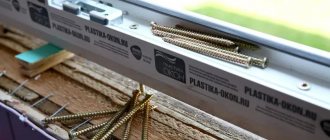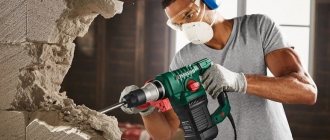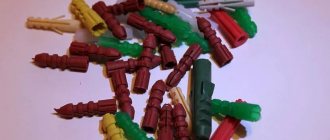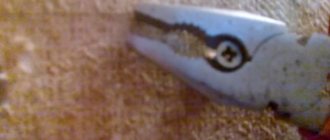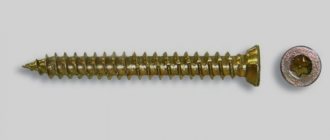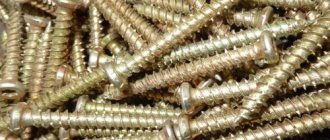Types and sizes
Depending on the type of head, all self-tapping screws can be divided into several independent groups.
Varieties with a countersunk head. Such models most often have a conical design with cross-shaped slots. To work with this variety, you first need to prepare a seat. To do this, you need to make a small chamfer, which will allow you to place the end so that it is in the plane of the material. Models with this head structure will not protrude above the concrete surface after installation. Today varieties with a reduced head are produced. They have a smaller diameter and provide a more reliable fastening, but more effort must be applied when installing them.
Self-tapping screws can also be divided into separate categories depending on their protective coating. Many models are produced with a special oxidized coating. The latter has the appearance of a thin oxide film, which gives the parts a black color. Such options can withstand significant loads, but we must not forget that they should not come into contact with moisture during operation.
There are also models coated with phosphated compounds. These varieties, like the previous version, will be painted black. They are also capable of fixing material of significant weight, and at the same time have good resistance to water. The cost of such models will be higher compared to other types.
Galvanized concrete screws can be white or yellow, but they practically do not differ from each other in important properties. These models are most often used for installing products that will be located outdoors, since these self-tapping screws are particularly resistant to various atmospheric influences.
Self-tapping screws are also classified depending on the material from which they are made. The most common option is high-strength and high-quality carbon steel. This foundation is considered quite strong. Most often it is used together with impurities. In addition, this metal is particularly durable. Fastening devices made from this metal are relatively inexpensive.
Also, ordinary stainless steel can be used to produce such self-tapping screws. This material will be the best option if contact of fasteners with moisture is possible in the future. After all, models made from such material will not rust and will not lose their properties.
As a rule, self-tapping screws made of alloy stainless steel are not coated with additional protective coatings. After all, such metal contains nickel and chromium, which already provide excellent anti-corrosion properties of products.
There are also special types of decorative screws. They are most often made of wood, plastic or various non-ferrous metals. But such samples are extremely rarely taken for concrete surfaces, since they cannot withstand too heavy loads.
The sizes of self-tapping screws for concrete may vary. They are selected depending on the thickness of the surface and the diameter of the holes made.
Tools may have different thread configurations.
- "Herringbone". This type is a slightly inclined thread, which is formed by small metal cones nested inside each other. The herringbone model most often has a cross-section of 8 millimeters.
- Universal. This type of self-tapping screw can be used with or without a dowel. As a rule, the tool is available in sizes up to 6 millimeters.
- With a variable pitch of turns. These samples with variable pitch provide the most reliable fastening of materials, while additionally performing notches. It is this type that is most often found on self-tapping screws without drilling. The standard diameter of such devices is 7.5 millimeters.
The length of these devices can vary from 50 to 185 mm. The depth ranges from 2.3 to 2.8 mm. The height of the cap reaches 2.8-3.2 mm. The diameter of such screws can be from 6.3 to 6.7 mm
The thread pitch also plays an important role. For different models it can reach a value of 2.5-2.8 mm
What can replace a nail?
Dowel instead of nail
When it comes to concrete, a nail is considered a poor solution.
You can replace it with a dowel.
It is sold in construction stores and is relatively inexpensive.
The buyer has a wide selection of products to choose from: plastic, metal, nylon.
If you need to hang a picture or a shelf, when hammering it in, you need to hold it at an angle from top to bottom.
Thus, the mount will become more reliable and will last for many years. In case of unexpected impact on the walls due to time or climate conditions, the interior part will not fall and will hold securely.
Special dowel-nails would also be an ideal option. They are designed to be driven directly into concrete. Concrete nails have thicker walls, so they won't break while working with them.
If it is possible to replace the nail with a more suitable solution, you should pay special attention to this
How to hammer a nail into a concrete wall: useful tips and tricks
They are widely used in attaching insulation materials, plasterboard and wood to brick and concrete walls. It is also preferable to work with such fasteners to create wooden sheathing before cladding a house with siding, clapboard or block house.
Ease of use, reliability and speed of operation are the main advantages of such dowels.
This makes them a very effective material for repair work of various sizes. Due to their special shape, such nails can be driven in with a hammer, without using a screwdriver or screwdriver.
tutmet.ru
Brick dowel. Types of self-tapping fasteners and their parameters
The classification of self-tapping screws for working on concrete without pre-drilling is carried out based on the material, special coating, shape of the slot and head, and type of thread notch. Anchor pins for concrete are manufactured strictly in accordance with GOST 1147-80. For the production of self-tapping screws, domestic or imported steel wire is most often used. The steel used is our carbon steel grades 08kp, 10kp, 10, 10ps and foreign grades – S1010, S1022, S1018. After the product is turned from a blank, its surface is hardened for strength. The following are used as protective measures:
- Galvanization. Using the galvanic method, a zinc layer is applied to the product to protect the screw from corrosion (the color is yellow or silver).
- Phosphating. The color is obtained black or gray due to the interaction of the steel product with phosphates.
- Oxidation. Obtaining a protective film on fasteners is carried out using an oxidizing agent. As a result of a chemical reaction, the dowel turns black.
Fasteners are used without special coating if they are made of alloyed stainless steel. The alloy has anti-corrosion properties. Self-tapping brass elements are durable and resistant to aggressive weapon conditions. Their disadvantage is their softness and tendency to deform.
The head of the hardware can be hidden, protruding, or can have a cylindrical, half-cone or hexagonal shape. The splines are made cross-shaped, hexagonal, Torx sprocket, barrel-shaped, socket-spanned. A straight slot is not used. He will not be able to convey the necessary effort to firmly tighten the self-tapping screw into dense heterogeneous flesh.
Self-tapping screws are made with different configurations:
- Universal. Here the fastener has a multifunctional purpose. It can be used with or without a dowel. Length does not exceed 220 mm, diameter - no more than 6 mm.
- In the form of a Christmas tree. An inclined threaded section is obtained using cones nested one inside the other. The length of the self-tapping screw is increased to 200 mm, the cross-section is increased to 8 mm. The part is driven into the prepared hole without a dowel or using one.
- With different frequency of turns. Such self-tapping screws hold stronger in concrete and can be worked with without using a dowel. They are also called turbo screws. This non-standard threaded notch is applied to the entire length of the dowel, which can take values from 52 mm to 212 mm, with an outer diameter of 7.5 mm.
General information
Although the modern construction market offers many options, self-tapping screws remain the most popular. They are screws of a rod-shaped, pointed shape, the head of which has a cross notch. Such a fastening element is characterized by high strength, which allows it not to bend or collapse under the influence of heavy loads.
How to use a concrete screw when working with foam concrete
Material
For the manufacture of self-tapping screws, various materials can be used, which are selected depending on the type and conditions of use.
The main ones are:
- carbon steel;
- stainless steel;
- brass.
The common feature of each of them is high strength, and their prices are not much different from each other.
The most common fasteners are made from carbon steel. Such self-tapping screws have an additional protective coating that protects them from oxidation and other types of influences.
Anchor screws for concrete
In order not to get confused about the types of coatings for carbon steel, you need to remember their color designation:
| Silver | In this case, the protective coating is a layer of zinc. Such self-tapping screws can be used equally effectively for various jobs. |
| Yellow | Such fasteners are also treated with zinc, but they have a slight drawback compared to silver ones. It can only be used when working with concrete indoors. |
| Black | Another type of coating for carbon steel screws is oxidized. They are recommended for use during interior work in rooms with normal air humidity levels. |
Before installing the self-tapping screw, make a hole for the dowel using a hammer drill
Kinds
Self-tapping screws can come complete with dowels or simply be screwed into the surface with your own hands without them.
Due to the various characteristics of the elements, they can be divided into three main groups, each of them characterized by different properties:
- Universal with medium thread pitch. The length range of such fasteners lies in the range of 12-220 mm, and the diameter is 3-6 mm. They can be used equally effectively with or without concrete anchors in foundations made of brick (concrete).
In the photo - a self-tapping screw with a herringbone thread
- With herringbone thread. The length range is similar to the first group, and the diameter can be in the range of 3-8 mm. These elements are secured only using dowels. To create a hole for the dowel, use a drill whose diameter is equal to the diameter of the dowel. The drilling depth should be 3-5 mm greater than the length of the latter, and the self-tapping screw should have a similar length.
Installation of self-tapping screws in concrete without drilling
- Pins are a variable type of thread with notches. Such elements have different lengths (ranging from 70-200 mm) and a constant diameter of 7.5 mm. It is used without a dowel. To install it, it is necessary to drill a hole Ø 6 mm in the base and a length exceeding the length of the self-tapping screw by 10-15 mm.
Screw device
Concrete screws are made of high-strength steel, passivated with special compounds to protect against corrosion and mechanical damage when screwed in. Depending on the alloy used for passivation, self-tapping screws are available in yellow, grey, black and silver.
RECOMMENDED ON THE TOPIC
- Concrete paint for exterior use
- Wood screws: dimensions, table
A screw consists of a head and a body - a metal rod with a thread. The lower part of the body of the self-tapping screw is narrowed in the form of a cone. There are notches applied to it that prevent the screws from unscrewing and falling out of the holes, and the concrete from cracking during installation.
The thread of the self-tapping screws also has notches that enhance its adhesion to concrete. The height of the thread along the body of the screw can vary. Hardware with uneven thread heights is widespread. They are suitable for working with cellular (porous) concrete (polystyrene concrete or wood concrete), brick (ceramic, silicate or Lego brick) and similar materials.
Self-tapping screws for concrete differ from conventional screws by having a more frequent thread pitch. It allows you to use dowels without drilling holes.
Product selection
There are several types of self-tapping screws, which differ from each other in the type of fastening, material and structure. The choice of one name or another depends on the situation and external influences that have a direct impact on the fastener. Let's look at the most common types of self-tapping screws and their scope of application.
Self-tapping screws with dowels
Self-tapping dowel for foam concrete with a plastic casing
This is the most common type of fastener on the construction market - they are produced in the form of self-tapping screws with two types of threads and plastic dowels. The presence of a dowel is explained by the fact that a hole drilled in concrete is not able to provide a tight fixation, without which the fastening will not be reliable. The plastic casing acts as a seal, which smooths out this circumstance as much as possible.
If you are selecting self-tapping screws for aerated concrete, then fastenings with dowels are the best option. Given the low density of the foam material, self-tapping screws for aerated concrete without a sealant will not be able to provide the required reliability factor.
The plastic casing increases the contact area of the self-tapping screw with the wall, which is especially important in the case of low-density concrete.
There are two types of self-tapping screws with dowels, which differ from each other in the structure of the thread.
Herringbone carving
- “Herringbone”. The herringbone profile is a non-communicating thread that is fixed in the hole using the principle of driving nails into concrete. Once fixed, such a self-tapping screw cannot be removed by unscrewing, which significantly complicates dismantling. However, they also do not need to be tightened - a few strong blows are enough, which in some cases can significantly simplify the installation process;
- Universal profile. This product looks like an ordinary self-tapping screw and is mounted accordingly. The screw is simply screwed into the dowel, and during dismantling it is removed by unscrewing. This type of fastening is somewhat inferior in reliability to the previous name.
Dowel fastening diagram
The dimensions of self-tapping screws for concrete range from 3 to 6 mm in diameter and from 12 to 220 mm in length of the product. Herringbone screws can be larger in diameter, but are somewhat limited in length.
Installation of self-tapping screws with dowels is carried out in pre-drilled holes, which must correspond to the diameter of the plastic casing. The dowel should fit tightly into the hole and not dangle. After which the fastening element itself is driven into it.
Self-tapping screws without dowel
Screws without dowel
Before screwing a self-tapping screw into concrete without a dowel, you need to drill a hole with a special drill with a diameter of 6 mm (the diameter of the dowels is 7.5 mm). Only after this is the screw screwed into the hole using a screwdriver - the variable notch will expand the cavity, and the upper thread will secure the self-tapping screw.
Variable thread screw
This type of fastening refers to stationary solutions - before screwing a self-tapping screw into concrete, you need to accurately determine its location, since after fixing, it will no longer be possible to unscrew the fastener.
Coverage type
For the most part, self-tapping screws for concrete are made of carbon steel, which is coated with a protective layer to protect against corrosion. The exception is stainless steel screws, but their price is an order of magnitude higher than their conventional counterparts.
There are several options for protective coating, among which the following should be highlighted:
Galvanized. The zinc layer has a characteristic metallic silver luster - this is the most reliable anti-corrosion coating today. This product can be used both indoors and outdoors;
Zinc and oxide coating
- Copper-plated. Yellow screws are copper or brass plated - their use is limited to interior work;
- Oxidized. Black self-tapping screws are blackened, as a result of which an oxide film is formed on their surface, which prevents the formation of rust. They can only be used in conditions with normal humidity.
Metal dowel nails
Dowel nails are consumables for mounting guns. These products are used in the construction and installation of structures made of concrete, metal, plastic, brick and other materials. With the help of such nails, so-called “permanent fasteners” are produced.
What requirements must a metal dowel-nail meet?
This type of fastener is made of hardened steel alloys. In our company you can buy dowel-nails with dimensions from 2.7x16mm to 3.05x38mm.
Using dowel-nails, wooden, steel, plastic and other elements are attached to structures made of concrete, brick and metal (“direct installation”). In order for the connection of such high-strength materials to be strong and reliable, the fastening must meet certain requirements:
- nail hardness 53 – 56 HRC;
- rod bending – no more than 0.1 mm;
- smooth transition of the end of the dowel into the cylindrical body (there should be no defects, cracks, or visible damage);
- The cap is covered with a protective layer of zinc for protection;
- pull-out load (65 kg or more).
Such characteristics allow the mounting dowel-nails to withstand enormous loads immediately after being fired from a gun, as well as during the process of passing through dense layers of fastened materials.
Catalog:
Sort by: namepricepopularity
There are both universal fasteners for most materials, and nails for certain structures:
- dowel nail for concrete;
- dowel nail for brick;
- dowel nail for hollow brick.
Features of operation
First of all, you need to select nails that are suitable for both the surface material and the elements being attached. The thickness of the base should be 3 times greater than the immersion depth of the dowel. The ideal distance at which a nail penetrates into the materials being fastened is considered to be 2.5 cm.
When using dowel nails for a gun, builders often encounter a number of problems. To avoid them, follow these recommendations:
- the dowel is pulled out or cut off. You have exceeded the load-bearing capacity of one fastening. It is necessary to reduce the step (attach the element at more points);
- the dowel-nail does not immerse. Increase gun power or change tools. Select the type of fastener you need (for example, use concrete nails for the appropriate surfaces);
- The dowel breaks. Recalculate the required length of the nail and reduce the power of the nail gun;
- damage to the cap after the shot. The problem is in the pistol piston; most likely it has become unusable.
When carrying out installation work, it is very important to select a dowel specifically for the material you are working with. The selection method is described in the instructions for using any powder or gas pistol.
Dowel-nails in
From us you can buy dowel nails for powder, gas and pneumatic pistols. Product material – galvanized hardened steel. The product is packaged in boxes of 1000 units each.
You can place an order on our website online, by calling or visiting our office in Moscow. Delivery throughout Russia using carrier companies (TK "Dostavka-Club", TK "Business Lines"). Pickup from the company's office is possible.
Use reliable materials when performing construction and installation work. Buy metal dowel nails from our company!
m3-m12.su
Turbo screws for concrete
Screws with variable threads (d 5 mm) are also often called self-tapping screws without drilling, dowels or turbo screws for concrete. These products are made from ultra-resistant materials (carbon, high-strength stainless steel or brass) and are treated with yellow protective coatings (galvanized galvanizing) to prevent corrosion.
The main distinguishing feature of the dowel is the variable thread with notches. It is thanks to it that the coefficient of adhesion to the concrete surface increases. A screwdriver is enough to screw in the dowel.
The length of turbo screws ranges from 52-212 mm, the width of the cross-shaped head (there are also products with a head in the shape of a star, barrel and hexagon) is 11 mm, and the cross-section of the rod is 7 mm (does not change regardless of length).
Healthy! The deeper the dowel is installed, the greater its load-bearing capacity becomes.
Most often, turbo screws are used when working with porous concrete and hollow blocks.
In addition to the type and color of hardware, you should also pay attention to some recommendations
Requirements for the location of screws
Before installing the screws, mark the locations for their installation. Do this by following these rules:
- the distance from the edge to the first fastening point is greater than two screw lengths;
- the hole is deeper than the length of the screw;
- in bases made of porous concrete, dowels (screws) with a length of 60 mm are used, in bases made of dense concrete – from 40 mm.
- anchors are located at a distance of 120 mm from one another in cellular concrete or 150 mm in dense concrete.
- The hardware is screwed in so that cold bridges do not form between them.
